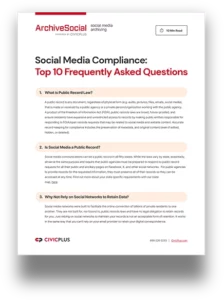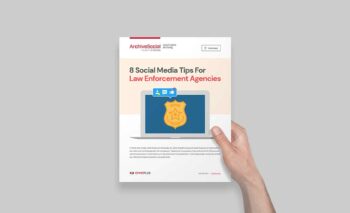Social Media for Law Enforcement
Social media for law enforcement enhances public communication, collaboration, and information exchange, making it indispensable for modern policing. It is a powerful tool that has transformed how law enforcement agencies engage with their communities, conduct investigations, and prevent crime. However, with great power comes great responsibility.
This article is designed to help law enforcement agencies maximize social media effectiveness while mitigating potential risks. Let’s dig in.
Social Media Guide for Law Enforcement: 5 Best Practices
According to data from the nonprofit Urban Institute, social media platforms are used by 91 percent of law enforcement agencies to notify the public about safety concerns, by 89 percent to support community outreach and engagement, and by 86 percent to conduct public relations and reputation management. But this list doesn’t encompass nearly all the nuanced ways in which agencies can leverage social media.
For example, many law enforcement agencies use social media to:
- Gather intelligence, collect evidence, monitor potential threats, investigate crimes, identify criminal networks, and locate suspects.
- Spread information rapidly to community members, which can be useful during public safety emergencies like natural disasters and wildfires.
- Host live question-and-answer sessions to engage directly with residents and address concerns.
- Highlight their agencies’ diversity to build trust with underrepresented groups in their communities.
- Share stories, data, and statistics about their agencies’ missions and activities to promote transparency, show accountability, and support recruiting.
- Collaborate with community members, local businesses, and charitable organizations with strong social media presences and similarly aligned values to foster goodwill.
This brings us to our first best practice.
1. Create a central communications strategy for your law enforcement agency.
With so many possibilities for the use of social media for law enforcement, agencies must develop an overarching communications strategy upon which channel-specific communication strategies can be built.
A social media channel-specific communications strategy might start with planning content types, topics, tones, and formats to align with agency goals and community needs. To garner engagement, the strategy could include tactics like responding to comments, participating in conversations, sharing user-generated content, and encouraging employees to reshare agency posts on their personal accounts to help amplify messages and humanize the badge.
Different agencies need different approaches. Just be sure to also have clear guidelines in place for handling negative content or situations on social media.
Related Read – How to Create a Crisis Communication Plan
2. Develop a social media policy for your law enforcement agency.
When it comes to social media, establishing criteria for law enforcement use is key. Ensure the criteria and language used in your agency’s social media policy is easy to understand and involves all relevant stakeholders. Your policy should comply with local, state, and federal laws, as well as social media user agreements. This social media policy template provides a practical baseline to help you get started.
Keep in mind that “the Internet is forever.” That is to say, once a statement has been posted online, it can be impossible to take it back. Even if you delete the statement, it may already have been captured or recorded in various ways. So social media users must be careful to say exactly what they mean. Police also must be sensitive to the privacy of others, and should always be respectful and patient.
At the same time, avoid over-sensitivity to risk, which can derail the development of social media initiatives. Focus on the rewards of thoughtful social media usage and actively work to alleviate risks in practice.
3. Hold social media training for dedicated law enforcement personnel.
It’s important to empower the right people to post and engage on social media on behalf of your agency. Designate a dedicated social media team, avoiding the dispersion of social media responsibilities across multiple departments or units.
Select individuals who can communicate clearly and sensitively. Training can enhance their skills, ensuring they view social media as integral to their roles. Bringing in experienced intelligence officers and experts in social media for law enforcement to lead your agency’s training can lend credibility.
4. Ensure proper archiving for your law enforcement agency’s social media.
Social media has transformed communication and engagement, making it a crucial tool for law enforcement agencies. However, its use also comes with public recordkeeping responsibilities. Proper handling of these records ensures transparency and builds trust with the community. It also helps protect agencies from costly legal compliance headaches.
Social media is considered a public record by law federally and in all 50 states. Government entities, including law enforcement agencies, are required to comply by capturing and archiving every record from their social media communications.
5. Leverage the right social media tools for law enforcement.
There are social media tools, and then there are the social media platforms themselves. Let’s start with the latter, since tools are typically designed to support platform usage.
According to data from the nonprofit Urban Institute, Facebook is the leading social media platform used by 94 percent of law enforcement agencies, followed by X (formerly Twitter) at 71 percent, and YouTube at 40 percent. The popularity of these platforms seems to ring true for many agencies.
For example, Social Media Manager Anthony Rodriguez of the Palm Beach County, Florida Sheriff’s Office (PBSO), host of the Social Media in Law Enforcement (SMILE) Conference, is quoted as saying:
- “We use Facebook Live to broadcast events and sheriff’s press conferences with real words, unedited, uncut.”
- “Twitter is the best way to get breaking news from the PBSO.”
- “The [PBSO YouTube channel] shows the good side of law enforcement — what it’s really about.”
- “NextDoor is a bulletin board to post information and concerns in the community. The sheriff’s department can post messages there.”
In addition, PBSO reportedly uses Instagram to share behind-the-scenes stories.
However, selecting a social media platform is a nuanced decision. Each platform brings distinct features and caters to various audiences and communication styles. Agencies must evaluate audience demographics, engagement metrics, and content types to find ideal matches.
Related Read – 8 Social Media Tips for Law Enforcement Agencies
As for social media tools, there are a plethora of options to support activities such as scheduling posts and reporting on performance. There are also options geared toward law enforcement work like monitoring and surveillance.
One of the handiest social media tools for law enforcement is automated social media archiving software. As a manual process, archiving can be time-consuming and frustrating — especially since screenshots are not compliant with public records laws. All communications sent or received by government administrations — including but not limited to police departments, sheriff’s offices, and their employees — are subject to public or open records requests. For this reason, law enforcement agencies must capture and archive every message. These records also might be needed for internal investigations, case logs, and potential litigation.
Embrace the Power of Social Media
Embracing the power of social media is essential for modern law enforcement agencies seeking to engage with their communities, conduct investigations, and prevent crime. By developing a comprehensive communications strategy and social media policy, training and empowering the right people, archiving social media communications properly, and utilizing the right tools, agencies can demonstrate transparency, foster community trust and credibility, and improve public safety.



